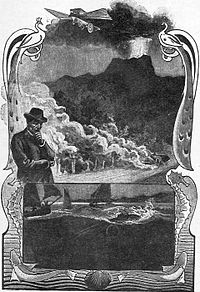- Master of the World (novel)
-
For other uses, see Master of the World (disambiguation).
Master of the World 
Illustration from the original publication. Drawing by Georges Roux.Author(s) Jules Verne Original title Maître du monde Cover artist Georges Roux Country France Language French Series The Extraordinary Voyages #53 Genre(s) Science fiction, adventure novel Publisher Pierre-Jules Hetzel Publication date 1904 Published in
English1911 Media type Print (Hardback) Pages 317pp ISBN N/A Preceded by A Drama in Livonia Followed by Invasion of the Sea Master of the World (French: Maître du monde), published in 1904, is one of the last novels by French pioneer science fiction writer, Jules Verne. At the time Verne wrote the novel, his health was failing, and Master of the World is a "black novel," filled with the fear of the coming of tyrants like the novel's villain, Robur, and totalitarianism.
Contents
Plot outline
A series of unexplained happenings occur across the eastern United States, caused by objects moving with such great speed that they are nearly invisible. The first-person narrator John Strock, 'Head inspector in the federal police department' in Washington, DC, travels to the Blue Ridge Mountains of North Carolina to investigate and discovers that all the phenomena are being caused by Robur, a brilliant inventor who had previously appeared in Verne's Robur the Conqueror.
Robur had perfected a new invention, which he has dubbed the Terror. This is a ten-meter long vehicle, that is alternately speedboat, submarine, automobile, or aircraft. It can travel at the (then) unheard of speed of 150 miles per hour on land and at over 200 mph when flying.
Strock attempts to capture the Terror but instead is captured himself. The strange craft eludes its pursuers and heads to the Caribbean where Robur deliberately heads into a thunderstorm. The Terror is struck by lightning and falls into the ocean. Strock is rescued from the vehicle's wreckage, but Robur's body is never found. The reader is left to judge whether he has actually died or not.
Literary significance & criticism
Master of the World contains a number of ideas, current to Verne's time, which are now widely known to be errors. A vehicle travelling at 200 mph is not invisible to the naked eye, nor does high speed reduce its weight.
Allusions/references
The novel's events take place in the summer of 1903, as characters refer to events of the Mount Pelée eruption on Martinique in 1902. Verne took a few liberties with American geography in the novel. The location in the book in the mountains of North Carolina is the city of Morganton, however, the specific mountain in the novel, called the Great Aerie, in name resembles Mount Airy, which is also in North Carolina, but not in the region near Morganton. Additionally, another portion of the novel takes place in a large deep natural lake in Kansas, whereas no such lake exists within that state.
Adaptations
- 1961 - Master of the World starring Vincent Price and Charles Bronson. In the script, Richard Matheson combined elements of this book (mainly the character, Strock) with more of the novel's predecessor, Robur the Conqueror (notably the Albatross rather than the Terror), and more sophisticated thematic elements of his own. An article in Filmfax magazine on American International Pictures included a photo of a model of the Terror for an unmade film called Stratofin, which was to be produced as the sequel to Master of the World.
- There is a more faithful version of this novel, with the same title as the 1961 film, that aired as a half-hour cartoon TV special in the late 1970s.
- Robur is a character in the 1995 novel The Bloody Red Baron as the chief airship engineer of the Central Powers. The chapter in which he and his airship flagship appear is titled "Master of the World."
- The Terror appears in the game Pirates of the Mysterious Islands.
External links
 Works related to The Master of the World at Wikisource
Works related to The Master of the World at Wikisource- Master of the World at Project Gutenberg
Works by Jules Verne Other works NovelsThe Waif of the Cynthia (1885) · The Lighthouse at the End of the World (1905) · The Golden Volcano (1906) · The Thompson Travel Agency (1907) · The Chase of the Golden Meteor (1908) · The Danube Pilot (1908) · The Survivors of the "Jonathan" (1909) · The Secret of William Storitz (1910) · The Barsac Mission (1919) · Paris in the Twentieth Century (1994, written 1863)
CollectionsDoctor Ox (1874) · Yesterday and Tomorrow (1910)Short stories"A Drama in Mexico" (1851) · "A Drama in the Air" (1851) · "Martin Paz" (1852) · "Master Zacharius" (1854) · "A Winter Amid the Ice" (1855) · "The Count of Chanteleine" (1864) · "The Blockade Runners" (1865) · "Dr. Ox's Experiment" (1872) · "An Ideal City" (1875) · "The Mutineers of the Bounty" (1879) · "Ten Hours Hunting" (1881) · "Frritt-Flacc" (1884) · "Gil Braltar" (1887) · "In the Year 2889" (1889) · "Adventures of the Rat Family" (1891) · "Mr. Ray Sharp and Miss Me Flat" (1893) · "The Eternal Adam" (1910)
Non-fictionHistoire des grands voyages et des grands voyageursCharacters and universe CharactersAouda · Tom Ayrton · David Farragut · Phileas Fogg · Lord Glenarvan · Captain Nemo · Jacques Paganel · Jean Passepartout · Cyrus Smith
Universe Book:Jules Verne ·
Book:Jules Verne ·  Category:Jules Verne ·
Category:Jules Verne ·  Portal:LiteratureCategories:
Portal:LiteratureCategories:- 1904 novels
- Novels by Jules Verne
- 1900s science fiction novels
- French science fiction novels
- Novels set in North Carolina
- 1903 in fiction
Wikimedia Foundation. 2010.
